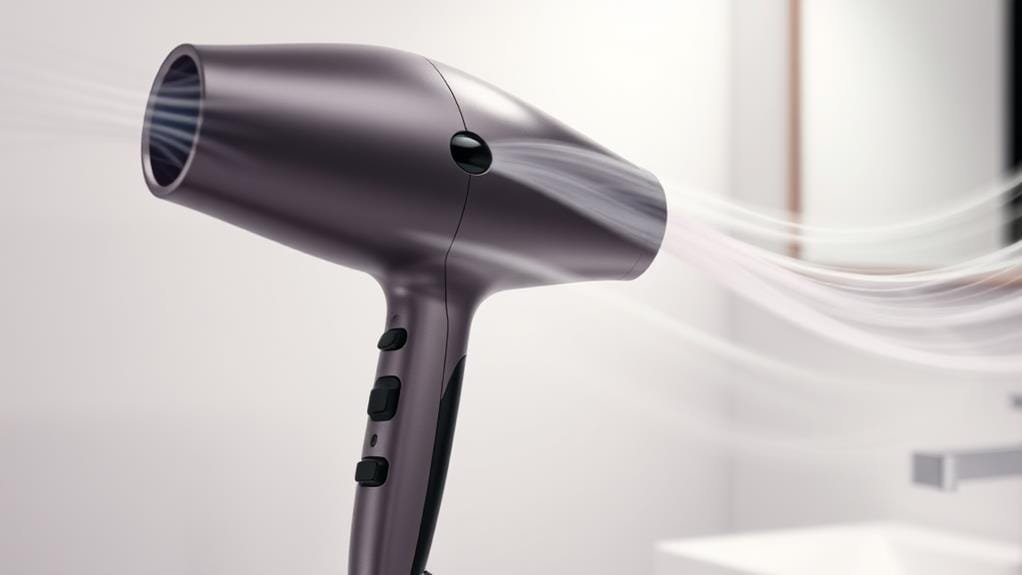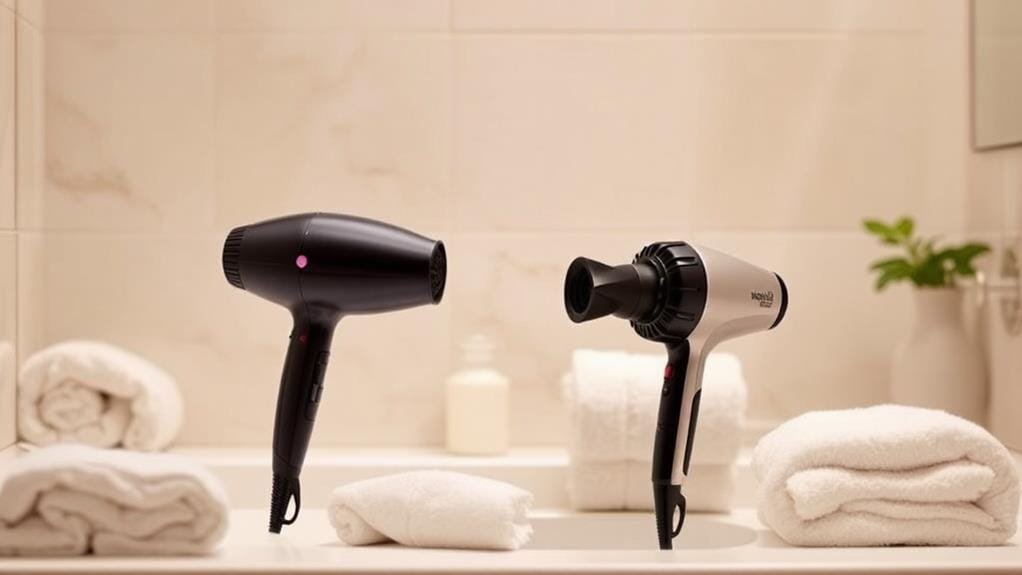A hairdryer's distinctive sound comes from its powerful motor whirring between 20,000 to 30,000 RPM and the turbulent airflow created within its casing. This buzzing noise, often compared to a busy street, results from rapidly spinning fan blades and airflow rushing through narrow passages. While traditional models can reach noise levels of 80 to 90 dB, innovations in design have led to quieter versions below 70 dB. Advanced materials and brushes dampen the sound, making your drying experience much more pleasant. Intrigued? There's more to explore about how sound and technology interact in your everyday appliances!
Key Takeaway
- Hairdryers generate distinctive sounds due to high-speed motor operation, typically ranging from 20,000 to 30,000 RPM.
- The noise levels of traditional hairdryers reach 80 to 90 dB, similar to busy street sounds.
- Airflow turbulence and interactions between motor, fan blades, and casing contribute to the unique sound profile.
- Modern designs utilize quieter motors and sound-dampening materials, reducing noise levels below 70 dB.
- Variations in casing materials and nozzle designs affect sound resonance, resulting in different auditory experiences.
Unique Sound Characteristics
When you turn on a hairdryer, you're immediately struck by its distinctive sound, which stems from the high-speed rotation of its motor operating between 20,000 to 30,000 RPM. This whirring noise is a hallmark of hair dryer noise, combining with the interaction of fan blades and air to create turbulence, generating a unique sound profile. In traditional hair dryers, sound levels can reach 80 to 90 dB—similar to a busy street! But don't worry; quieter models are here to save the day.
Modern hairdryers, thanks to advanced motor designs and digital technology, often operate below 70 dB, making them much more pleasant to use. You'll appreciate how accessories like nozzle designs and sound-dampening materials can enhance noise reduction, allowing for a more enjoyable drying experience. The casing materials and design also play an essential role in how sound resonates, amplifying or dampening certain frequencies.
Major Noise Sources

The sound of a hairdryer is shaped primarily by its motor, fan blades, and the turbulence created by airflow during operation. When you switch on your dryer, the motor powers high-speed rotation, generating significant noise levels that typically range from 80 to 90 dB. That's comparable to busy streets or a blender! To reduce the noise level of your hairdryer, choose a model with a quieter motor and fan design. Additionally, using a diffuser attachment can help to minimize the turbulence of airflow and sound. In addition to noise reduction, proper maintenance of your hairdryer, such as cleaning the filter and fan blades, can also improve its overall performance. For more hair care tips, consult a professional stylist or hair care expert.
Fan designs play an essential role too. As air is forced through narrow passages, it creates airflow turbulence, amplifying the sound frequencies you hear. The interaction between the motor, fan, and casing produces vibrations, adding to the noise profile. This is why you often notice that distinctive roar when drying your hair.
Fortunately, manufacturers are aware of these challenges. Innovative designs are emerging to help reduce sound emissions without sacrificing performance. Look for hairdryers that boast quieter motors and improved fan blade configurations. These advancements guarantee that you can enjoy a peaceful experience while still achieving fabulous results. So, the next time you use your hairdryer, remember, it's not just a tool; it's a symphony of engineering working to make you look great!
Measurement Techniques

In recent years, measuring the noise output of hairdryers has become more sophisticated, thanks to advancements in acoustic testing methods. By utilizing noise measurement techniques in semi-anechoic chambers, you can accurately assess sound pressure levels while isolating external noise influences. This is essential for ensuring safety and comfort in your environment.
You can analyze each component of a hairdryer, like the motor and fan, to determine their contribution to overall noise output. With affordable software tools, you can rank noise sources through systematic measurement, allowing for targeted noise reduction strategies. It's fascinating how experimental methodologies from related fields can deepen your understanding of how hairdryer design impacts noise levels.
Research shows that by optimizing component design and using noise-dampening materials, you could achieve sound level decreases of 9.6% to 15%. That's a significant reduction! So, whether you're searching for a quieter hairdryer or simply curious about the technology behind it, knowing these measurement techniques can help you appreciate the effort put into minimizing the noise generated by air. Embrace these advancements for a more peaceful drying experience!
Health Impacts of Noise

Excessive noise from hairdryers can have serious health implications, especially with prolonged exposure. Hairdryers can generate noise levels ranging from 80 to 90 dB—comparable to busy traffic! This kind of noise can lead to hearing damage, which is a real concern for both users and professionals. Research shows hairdressers often report significant auditory complaints, with lower Speech, Spatial, and Hearing in Noise (SSQ) scores than non-hairdressers.
The World Health Organization warns that continuous noise exposure should not exceed 70 dB to prevent hearing-related health problems. Yet, many underestimate the risks tied to frequent use of hairdryers. This is especially vital if you're using one daily, as the cumulative effects of occupational noise exposure can lead to conditions like tinnitus or changes in hearing perception.
To protect yourself, consider implementing protective measures, like using quieter models or wearing ear protection. Awareness is key! Understanding the health impacts of hairdryer noise can help you make informed choices, ensuring you keep your hearing safe while enjoying that salon-quality blowout. Let's prioritize our health—after all, who wants to be left with not just fabulous hair, but also a side of hearing loss?
Noise Reduction Innovations

With advancements in technology, hairdryers are becoming quieter and more efficient than ever before. Noise reduction innovations are transforming your drying experience, guaranteeing you can style your hair without the overwhelming din of traditional models. One significant breakthrough is the use of brushless DC motors, which not only reduce noise but also enhance energy efficiency.
Additionally, manufacturers now incorporate acoustic dampening materials in their designs. These materials absorb sound waves, effectively isolating and minimizing motor noise during use. Optimizing internal configurations further aids in this effort by reducing component vibrations and sound reflections, leading to quieter hair dryers.
Advanced airflow designs play an essential role too. They limit turbulence, resulting in lower noise production while maintaining effective drying capabilities. Finally, heat control technologies in modern dryers secure drying efficiency without compromising sound levels, delivering a pleasant user experience.
With all these innovations, you'll find a more peaceful atmosphere while you dry your hair, making your daily routine not just quicker, but also more enjoyable. Say goodbye to annoying hair dryers noise and hello to a quieter, more efficient styling experience!
Selecting Quieter Models

Choosing quieter hair dryer models is essential for anyone seeking a more serene styling experience. You don't want your hair routine to sound like a jet engine! Look for options that feature brushless DC motors, which greatly reduce audible noise compared to traditional models. For instance, the Dyson Supersonic operates below 70 dB, making it a fantastic choice for those sensitive to sound.
When evaluating high-speed hair dryers, consider the Laifen Swift, known for its noise-reduction technology that achieves an impressive sound level of just 59 dB. It's all about combining performance with peace. Additionally, the Panasonic EH-NA65-K is specifically designed to minimize airflow turbulence, ensuring a quieter experience while still delivering excellent drying times.
Don't forget to check product specifications and consumer feedback. This can help you pinpoint models with advanced acoustic features that contribute to a more peaceful user experience. By selecting a quieter hair dryer, you're not just investing in your hair; you're also prioritizing your well-being. With these tips, you'll enjoy your hair routine without the overwhelming noise!
Frequently Asked Questions
Why Does My Hair Dryer Make a Strange Sound?
If your hair dryer makes a strange sound, it could be due to vibrations from motor wear, airflow turbulence from lint buildup, or electrical issues. Regular maintenance and checking housing design can help prevent these problems.
Why Does My Dryer Sound Different?
If your dryer sounds different, check the motor speed and fan design. Hair dryer vibration and airflow dynamics can change sound frequency. Consider product age and maintenance tips, as resonance effects may indicate material quality or usage environment issues.
Why Does the Sound of a Hair Dryer Make Me Sleepy?
The hair dryer's soothing sounds create a white noise effect, promoting relaxation techniques that aid sleep inducement. These auditory stimuli can enhance personal comfort, aligning with your noise preferences and temperature effects, making you feel cozy and safe.
Why Is My Hair Dryer Making a Popping Noise?
If your hair dryer's making a popping noise, check for airflow restrictions or motor wear. Prioritize hair dryer maintenance, inspect internal components, and consider troubleshooting tips for electrical issues to guarantee user safety and prevent heat build-up.
Conclusion
So, next time you grab your hairdryer, remember it's not just a tool; it's a symphony of sound! With noise levels often reaching up to 90 decibels, that's comparable to a motorcycle revving up! Understanding these unique sound characteristics can help you choose quieter models and even consider innovative designs. Embrace the science behind the noise, and you might just find yourself enjoying the drying process a little more—minus the ear-splitting racket!





